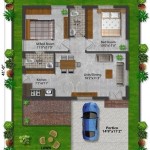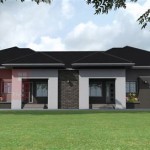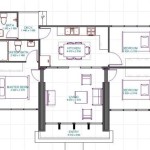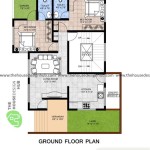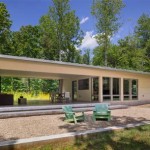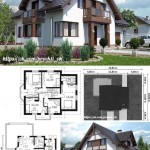House Floor Plans with Wrap-Around Porches: Design and Considerations
The integration of a wrap-around porch into a house floor plan represents a significant architectural decision that impacts both the aesthetic appeal and functional use of a dwelling. This feature extends living space outdoors, creating a seamless transition between the interior and exterior environments. When considering incorporating a wrap-around porch, several factors related to the floor plan must be carefully evaluated to ensure optimal design and usability.
Wrap-around porches are characterized by their extension along multiple sides of a house, typically wrapping around at least two facades and often encompassing the entire perimeter. This design offers a multitude of benefits, including enhanced curb appeal, increased outdoor living space, and improved thermal regulation within the house. Given the substantial area involved, the floor plan must be meticulously designed to accommodate the porch while maintaining the structural integrity and efficient flow of interior spaces.
Key Considerations for Integrating a Wrap-Around Porch into a House Floor Plan
Several critical factors need consideration when designing a house floor plan with a wrap-around porch. These include the porch's dimensions and proportions, the relationship between interior rooms and porch access points, and the overall structural integration of the porch with the main house structure. Overlooking these factors can lead to design flaws that compromise the functionality and aesthetic value of the intended living space.
Porch Dimensions and Proportions
The dimensions of a wrap-around porch, including its width and height, are fundamental considerations. The width determines the usability of the porch, dictating the amount of space available for furniture placement, foot traffic, and other activities. A porch that is too narrow may feel cramped and restrict movement, while an excessively wide porch may detract from the visual balance of the house. A width of at least eight feet is often recommended to provide ample space for comfortable seating and passage. Ideally, the width should be proportionate to the overall size and style of the house, maintaining a harmonious relationship between the porch and the main structure.
The height of the porch also plays a role in its functionality and aesthetic appeal. The height of the porch roof must be carefully calculated to provide adequate headroom while avoiding an overly imposing appearance. Typically, the porch roof should be lower than the main roof of the house to emphasize the primary structure. The height of the porch floor above ground level should also be considered. A slightly raised porch provides better drainage and visual separation from the surrounding landscape, but steep steps should be avoided to ensure accessibility for all residents and guests.
The proportions of the porch in relation to the house's facades are crucial for achieving a balanced and aesthetically pleasing design. The porch should not overwhelm the house or appear disproportionately large. The columns supporting the porch roof should be evenly spaced and appropriately sized to provide structural support and visual harmony. The overall design should complement the architectural style of the house, enhancing its curb appeal and creating a cohesive appearance. A careful consideration of these dimensions and proportions is essential for a successful wrap-around porch design.
Relationship Between Interior Spaces and Porch Access Points
The accessibility and connectivity between the interior rooms and the wrap-around porch significantly influence the flow and usability of the space. Thoughtful placement of doors and windows is crucial to creating a seamless transition between indoor and outdoor living areas. Integrating multiple access points from various rooms can enhance the functionality and appeal of the porch, making it an integral part of the living space.
Rooms such as the living room, dining room, and kitchen often benefit from direct access to the porch. French doors or sliding glass doors can provide expansive openings that blur the lines between the interior and exterior, allowing natural light and ventilation to flow freely. Strategic placement of these access points can create a natural extension of the interior spaces, enhancing the living area and encouraging outdoor activities. The number and placement of these entry points should be carefully considered, ensuring ample access without compromising the privacy and security of the interior rooms.
The orientation of the access points also impacts the functionality of the porch. Doors and windows facing specific directions can influence the amount of sunlight and wind exposure the porch receives. Designing access points to take advantage of prevailing breezes can enhance natural ventilation and create a comfortable outdoor environment. The placement of access points should also consider the surrounding landscape and views, maximizing the visual connection between the interior and exterior spaces. Thoughtful consideration of these factors can transform a wrap-around porch from a mere addition to an integral part of the overall living experience.
Beyond direct access, window placement should also be considered. Large windows facing the porch area allow for plentiful natural light to enter the home, reducing the need for artificial lighting during the day. They also provide visual connectivity, allowing occupants to enjoy views of the surrounding landscape from inside the home. This connectivity can enhance the sense of spaciousness and create a more harmonious living environment.
Structural Integration of the Porch with the Main House Structure
The structural integration of the wrap-around porch with the main house structure is paramount for ensuring stability and longevity. The porch must be properly supported and connected to the house to withstand various environmental factors, including wind, rain, and snow. The construction materials and techniques used should be consistent with the overall architectural style of the house, creating a cohesive and durable structure.
The porch should be supported by a solid foundation, typically consisting of concrete footings or a continuous foundation wall. The foundation should extend below the frost line to prevent damage from freezing and thawing cycles. The porch columns or posts should be securely anchored to the foundation and properly spaced to provide adequate support for the porch roof. The roof structure should be designed to handle the expected snow load and wind forces in the local area, ensuring the safety and stability of the porch.
The connection between the porch roof and the main house roof should be carefully detailed to prevent water intrusion and maintain a seamless appearance. Flashing and weatherproofing materials should be used to seal the joint between the two roofs, preventing leaks and water damage. The porch roof should be sloped to allow for proper drainage, directing water away from the house and preventing ponding. The overall structural design should comply with local building codes and regulations, ensuring the safety and durability of the porch and the main house.
Selecting materials that match the architectural style of the house are essential for visual harmony. For example, a traditionally styled home might employ wooden columns and railings, while a more modern residence could utilize metal or composite materials. The chosen materials should also be durable and weather-resistant, able to withstand the elements and maintain their appearance over time. Careful planning and attention to detail during the structural integration phase can ensure that the wrap-around porch is a safe, functional, and aesthetically pleasing addition to the house.
Enhancing the Functionality of a Wrap-Around Porch Floor Plan
To maximize the benefits of a wrap-around porch, the floor plan can incorporate specific features and design elements that enhance its functionality and usability. These enhancements can transform the porch from a simple outdoor space into a versatile living area that can be enjoyed year-round.
Incorporating Screens and Enclosures
Adding screens or enclosures to a portion of the wrap-around porch can create a protected outdoor space that is shielded from insects, wind, and sun. Screened porches allow for comfortable outdoor living even during inclement weather or when insects are prevalent. Enclosures can provide even greater protection, allowing the porch to be used as a three-season room or even a year-round living space with the addition of heating and cooling systems.
Screens can be integrated into the porch design using a variety of materials, including traditional mesh screens, retractable screens, or even custom-built screen panels. Retractable screens offer the flexibility of opening up the porch to the outdoors when desired or closing it off for protection. Enclosures can be constructed using glass panels, sliding doors, or even insulated walls, creating a fully enclosed space that can be heated or cooled as needed. The choice of materials and design should be consistent with the overall architectural style of the house, maintaining a cohesive and aesthetically pleasing appearance.
The location of the screened or enclosed portion of the porch should be carefully considered. Orienting the enclosure towards the prevailing wind direction can enhance natural ventilation and create a comfortable outdoor environment. Positioning the enclosure to capture sunlight during the winter months can provide passive solar heating and reduce energy costs. The layout of the enclosure should also consider the surrounding landscape and views, providing a pleasant and inviting space for relaxation and entertainment.
Creating Outdoor Living Areas
The floor plan can be designed to incorporate specific outdoor living areas within the wrap-around porch, such as a dining area, a seating area, or an outdoor kitchen. These areas can be defined using furniture arrangements, outdoor rugs, or even changes in flooring material. Creating distinct zones within the porch can enhance its functionality and make it a more versatile living space.
An outdoor dining area can be created by placing a table and chairs near a doorway leading to the kitchen or dining room. This allows for easy access to food and drinks and creates a natural extension of the indoor dining space. A seating area can be defined by arranging comfortable outdoor furniture, such as sofas, chairs, and coffee tables. Adding an outdoor fireplace or fire pit can create a cozy and inviting gathering spot. An outdoor kitchen can be equipped with a grill, sink, and countertop space, providing a convenient area for preparing and cooking meals outdoors.
The placement of these outdoor living areas should consider the orientation of the porch, the surrounding landscape, and the intended use of the space. Orienting the dining area towards a scenic view can enhance the dining experience. Positioning the seating area to take advantage of afternoon shade can create a comfortable and relaxing space. Designing the outdoor kitchen with proper ventilation and lighting can make it a safe and functional cooking area. Thoughtful planning and design can transform the wrap-around porch into a vibrant and inviting outdoor living space that can be enjoyed year-round.
Adding Storage and Utility Features
Integrating storage and utility features into the wrap-around porch design can enhance its functionality and convenience. Adding built-in benches with storage compartments can provide ample space for storing outdoor cushions, gardening tools, or other items. Incorporating an outdoor sink or hose bib can make it easier to water plants, wash pets, or clean outdoor equipment. Adding electrical outlets and lighting fixtures can provide power and illumination for outdoor activities.
Storage compartments can be integrated into the porch design by adding built-in benches along the perimeter or creating custom storage cabinets. These compartments can be used to store a variety of items, keeping the porch clutter-free and organized. An outdoor sink can be installed near a water hose bib, providing a convenient area for washing hands, cleaning gardening tools, or rinsing off after outdoor activities. Electrical outlets can be strategically placed throughout the porch, providing power for lighting, fans, or other appliances. Lighting fixtures can be used to illuminate the porch at night, enhancing its safety and security.
The placement of these storage and utility features should consider the intended use of the porch and the surrounding landscape. Locating storage compartments near the seating area can make it easier to access outdoor cushions and blankets. Positioning the sink near the garden can make it more convenient to water plants. Placing electrical outlets near the dining area can provide power for outdoor lighting and appliances. Thoughtful integration of these features can significantly enhance the functionality and convenience of the wrap-around porch, making it a more valuable and enjoyable outdoor living space.

3 Bedroom Open Floor Plan With Wraparound Porch And Basement

Complete Wrap Around Porch 58304sv Architectural Designs House Plans

Country Style House Plan With Wrap Around Porch

Ardmore Park Country Home Farmhouse Floor Plans House Style

Wrap Around Porch House Plans For A 4 Bedroom Country Home

Country Style House Plan With Wrap Around Porch Farmhouse Plans New
:max_bytes(150000):strip_icc()/porch-houseplan-1-38165edff22544bb8696ee285d2d9bb0.jpeg?strip=all)
These Southern Living House Plans Have Dreamy Porches

Modern Farmhouse Plan With Wraparound Porch 70608mk Architectural Designs House Plans

Southern Living Dreamy House Plans With Front Porches Blog Dreamhomesource Com

Country Farm House With Wrap Around Porch First Floor Plan Sdl Custom Homes

